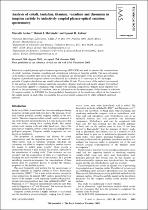 ResearchSpace
ResearchSpace
Analysis of cobalt, tantalum, titanium, vanadium and chromium in tungsten carbide by inductively coupled plasma-optical emission spectrometry
JavaScript is disabled for your browser. Some features of this site may not work without it.
- ResearchSpace
- →
- Research Publications/Outputs
- →
- Journal Articles
- →
- View Item
| dc.contributor.author |
Archer, M

|
|
| dc.contributor.author |
McCrindle, RI

|
|
| dc.contributor.author |
Rohwer, ER

|
|
| dc.date.accessioned | 2007-06-12T07:23:01Z | |
| dc.date.available | 2007-06-12T07:23:01Z | |
| dc.date.issued | 2003-12 | |
| dc.identifier.citation | Archer, M, McCrindle, RI and Rohwer, ER. 2003. Analysis of cobalt, tantalum, titanium, vanadium and chromium in tungsten carbide by inductively coupled plasma-optical emission spectrometry. Journal of Analytical Atomic Spectrometry, vol. 18(12), pp 1493-1496 | en |
| dc.identifier.issn | 0267-9477 | |
| dc.identifier.uri | http://hdl.handle.net/10204/529 | |
| dc.description | Copyright: 2003 Royal Society of Chemistry | en |
| dc.description.abstract | Inductively coupled plasma optical emission spectroscopy (ICP-OES) was used to measure the concentrations of cobalt, tantalum, titanium, vanadium and chromium in solutions of tungsten carbide. The main advantage of the method described here lies in the speed, convenience and effectiveness of the dissolution procedure. Aliquots of powdered tungsten carbide were dissolved in a solution of 5% aqua regia in 30% hydrogen peroxide. Complete dissolution was usually achieved within 10 min. The accuracy of the method was assessed by the analysis of certified reference materials, secondary reference materials and matrix spiking. The method was successfully applied to commercial type samples with differing compositions. Slightly more emphasis was placed on the measurement of vanadium, since no information on the measurement of-this element in solutions of tungsten carbide, by ICP-OES, has been published. The purpose of the study was to provide an alternative, more rapid and less expensive method of dissolving tungsten carbide–cobalt using only nitric acid, hydrochloric acid, hydrogen peroxide and tartaric acid. In this manner, no additional metallic elements were introduced into the sample matrix and the use of hydrofluoric acid was avoided. Investigation of the interference effects of the elements in the sample matrix on each other was essential for accurate results comparable to other published analytical methods. | en |
| dc.language.iso | en | en |
| dc.publisher | Royal Society of Chemistry | en |
| dc.subject | ICP - OES | en |
| dc.subject | Inductively coupled plasma optical emission spectroscopy | en |
| dc.subject | Tungsten carbide - cobalt | en |
| dc.subject | Metallic elements | en |
| dc.subject | Physical chemistry | en |
| dc.title | Analysis of cobalt, tantalum, titanium, vanadium and chromium in tungsten carbide by inductively coupled plasma-optical emission spectrometry | en |
| dc.type | Article | en |
| dc.identifier.apacitation | Archer, M., McCrindle, R., & Rohwer, E. (2003). Analysis of cobalt, tantalum, titanium, vanadium and chromium in tungsten carbide by inductively coupled plasma-optical emission spectrometry. http://hdl.handle.net/10204/529 | en_ZA |
| dc.identifier.chicagocitation | Archer, M, RI McCrindle, and ER Rohwer "Analysis of cobalt, tantalum, titanium, vanadium and chromium in tungsten carbide by inductively coupled plasma-optical emission spectrometry." (2003) http://hdl.handle.net/10204/529 | en_ZA |
| dc.identifier.vancouvercitation | Archer M, McCrindle R, Rohwer E. Analysis of cobalt, tantalum, titanium, vanadium and chromium in tungsten carbide by inductively coupled plasma-optical emission spectrometry. 2003; http://hdl.handle.net/10204/529. | en_ZA |
| dc.identifier.ris | TY - Article AU - Archer, M AU - McCrindle, RI AU - Rohwer, ER AB - Inductively coupled plasma optical emission spectroscopy (ICP-OES) was used to measure the concentrations of cobalt, tantalum, titanium, vanadium and chromium in solutions of tungsten carbide. The main advantage of the method described here lies in the speed, convenience and effectiveness of the dissolution procedure. Aliquots of powdered tungsten carbide were dissolved in a solution of 5% aqua regia in 30% hydrogen peroxide. Complete dissolution was usually achieved within 10 min. The accuracy of the method was assessed by the analysis of certified reference materials, secondary reference materials and matrix spiking. The method was successfully applied to commercial type samples with differing compositions. Slightly more emphasis was placed on the measurement of vanadium, since no information on the measurement of-this element in solutions of tungsten carbide, by ICP-OES, has been published. The purpose of the study was to provide an alternative, more rapid and less expensive method of dissolving tungsten carbide–cobalt using only nitric acid, hydrochloric acid, hydrogen peroxide and tartaric acid. In this manner, no additional metallic elements were introduced into the sample matrix and the use of hydrofluoric acid was avoided. Investigation of the interference effects of the elements in the sample matrix on each other was essential for accurate results comparable to other published analytical methods. DA - 2003-12 DB - ResearchSpace DP - CSIR KW - ICP - OES KW - Inductively coupled plasma optical emission spectroscopy KW - Tungsten carbide - cobalt KW - Metallic elements KW - Physical chemistry LK - https://researchspace.csir.co.za PY - 2003 SM - 0267-9477 T1 - Analysis of cobalt, tantalum, titanium, vanadium and chromium in tungsten carbide by inductively coupled plasma-optical emission spectrometry TI - Analysis of cobalt, tantalum, titanium, vanadium and chromium in tungsten carbide by inductively coupled plasma-optical emission spectrometry UR - http://hdl.handle.net/10204/529 ER - | en_ZA |





